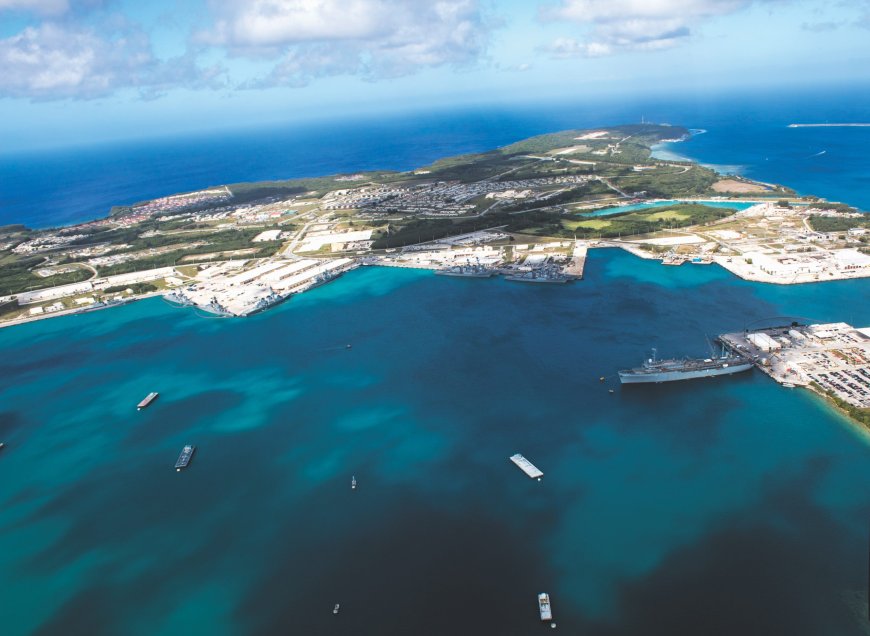Will Guam Be America’s Next Pearl Harbor?


While much of the world is focused on Donald Trump’s selling out of Ukraine and aggressive threats toward America’s peaceful neighbors Mexico, Canada, Panama, and Greenland, if you’re in U.S. military intelligence, you’re more likely to be tracking with concern a specific Chinese threat to a piece of geography that is not in the headlines. The DF-26 intermediate-range ballistic missile represented a major upgrade of President Xi Jinping’s war-fighting toolbox when it entered service in 2016. The missile (of which about 250 have been built) is precise enough to target aircraft carriers, and it can be equipped with nuclear as well as conventional warheads. But perhaps the most striking thing about the DF-26 is its 2,500-mile range. That’s not enough to reach the continental United States, but it certainly suffices to target America’s westernmost territory in the Pacific. That’s why the DF-26 is sometimes called “the Guam killer.”
Americans rarely spare a thought for Guam, which bills itself as the place where “America’s day begins.” Most voters in this country don’t know that the island is part of the United States, or that its 150,000 native inhabitants are U.S. citizens in every way except their right to vote in presidential elections. Even fewer would be able to find it on a map. But such ignorance doesn’t apply to our armed forces, who know the island by another nickname: “the tip of the spear.”
Defense planners are acutely aware that any potential conflict with China will immediately involve Guam. When the Center for Strategic and International Studies (CSIS) war-gamed a Chinese invasion of Taiwan two years ago, the simulated Chinese side attacked the island’s Andersen Air Force Base “in every iteration.” The war game planners knew what they were doing. Five years ago, the People’s Liberation Army Air Force put out a video showing one of its bombers carrying out a simulated attack on Guam. The message is clear.
Defense planners are aware that any conflict with China will immediately involve Guam. When CSIS war-gamed a Chinese invasion of Taiwan two years ago, the simulated Chinese side attacked the island’s air force base “in every iteration.”
Geography, politics, and strategy conspire to make Guam a tempting target. As the American territory nearest to China, the island is a vital strategic strongpoint. U.S. forces in Japan, South Korea, or the Philippines might be closer to Taiwan in the event of war, but Guam has one big advantage over them: Washington wouldn’t have to ask for another country’s permission if it wanted to send its forces there into a conflict—something that becomes especially important in a fight over Taiwan, in which every second counts. Security experts in Washington are fretting over the possibility that a war with China could come as soon as 2027; at least one Navy admiral has raised the possibility that it could happen earlier. Is the American military prepared to defend Guam and its 170,000 residents, 20,000 of whom are members of the U.S. armed forces and their dependents? And if it can’t defend Guam, can it come to the aid of Taiwan if the island nation is attacked by China? There are reasons to doubt it.
“Without holding Guam, defending Taiwan would be difficult,” Brent Eastwood recently wrote in The National Interest. Over the past few years that realization seems to have percolated through to the U.S. defense establishment, which has been trying to fortify the island accordingly. There are now some 9,700 uniformed personnel on Guam, up from 2,500 around the turn of the century. The U.S. Navy currently homeports five Los Angeles–class submarines there, and has the capacity to host a number of additional vessels, up to and including aircraft carriers, as circumstances demand. Andersen Air Force Base, on the north end of the island, is the only place in the Western Pacific that can service strategic bombers; up to 150 aircraft can park at the site, which has the largest fuel storage capacity (66 million gallons) of any base in the Air Force. The Air Force doesn’t station any airplanes there permanently, though, as things stand now.
The Chinese know all of this—and probably a great deal more. It is an open secret that the island has become a major focus of Beijing’s intelligence-gathering efforts. According to reports, the Chinese spy balloon that caused such a ruckus as it floated over the continental U.S. two years ago was supposed to be conducting surveillance over Guam before it went rogue. Also in 2023, the U.S. uncovered a huge Chinese cybercampaign that attempted to install malware in the civilian power and communications systems on the island. James Moylan, Guam’s delegate to the U.S. House of Representatives, told Politico the attacks were “clear signs that China wants to gain an edge over the U.S., starting with Guam.”
In December, seven Chinese citizens were arrested after trying to illegally enter the island during a sensitive missile defense test. The Guam Customs and Quarantine Agency said that four of the spies were found “in the vicinity of a military installation,” and noted that since 2022 it had responded to “a total of 152 individuals from the PRC who were determined to be in violation of Guam entry law.”
Back when I paid my first visit to Guam in 2007, military planners were just beginning to wake up to the implications of China’s rising power. In particular, there was a great deal of excited talk about boosting Guamanian defense capacity by bringing in 8,000 Marines from the Japanese island of Okinawa. The Marine presence on Okinawa has long been a bone in the throat of the civilian population there, who are tired of the noise and mess generated by the base—not to mention several high-profile cases of rape committed by U.S. military personnel. Japanese officials accordingly welcomed the news that a sizable number of Marines might be leaving the island. Washington and Tokyo first agreed on the transfer in 2006, then revised the terms of the deal in 2012.
Guam is still waiting. Last year, a first contingent of Marines finally made the move—but there were only 100 of them. They were billed as “logistics” specialists who are supposed to pave the way for the rest. The Marine Corps plans to make the island home to a permanent force of 1,300 Marines, with another 3,700 rotating in and out. But the Department of Defense is still working out where to put the thousands who are yet to show up. In 2023, the Marine Corps activated a new base, Camp Blaz, to house the new arrivals.
Obstacles abound. Housing, schools, and other support facilities still need to be built. Guam’s infrastructure, including communications, water, and power systems, is notoriously deficient. If the Army decides to move forces to a permanent base on the island, which looks likely, that could squeeze the space available for the Marines. One-quarter of the island is owned by the Defense Department—but the island is only 30 miles long, so space is at a premium. Both Apra Harbor, used by the Navy for its ships, and Andersen Air Force Base have infrastructure improvements underway, which merely underlines the extent to which the needs of the island have been neglected in the past.
The military is also trying to make up for lost time by addressing a more fundamental strategic issue: Guam is vulnerable. It’s a vitally important but small chunk of real estate, crammed with juicy assets, in the middle of a vast ocean. Intermediate-range ballistic missiles aren’t the only attack option for Beijing. The island’s defenses might also have to contend with ship- or submarine-launched cruise missiles, and potentially even hypersonic glide vehicles the Chinese currently have under development. Guam is also under threat from North Korea, which has produced missiles capable of reaching the island.
The strengthening of Guam’s defenses began under the Obama administration. In 2013, even before China had missiles that could reach the island, the Defense Department brought in a Terminal High Altitude Area Defense (THAAD) system (one of seven deployed by the Army around the world), which is designed to protect against ballistic missile attacks at ranges of up to 125 miles.
Preparations largely stalled during Donald Trump’s first term. Retired General John Kelly, who served as Trump’s first chief of staff during those years, later recalled how the two of them once discussed scenarios for a possible North Korean attack. When he tried to explain that a possible North Korean raid might take lives across the Pacific, given that Guam was within missile range, Trump responded: “Guam isn’t America.” Trump’s obliviousness seems especially odd considering his oft-proclaimed affection for the expansionist polices of William McKinley—who happens to be the very president who added Guam to the U.S. empire in 1898, after the Spanish-American War.
Under Joe Biden, the bolstering of Guam ramped up considerably. That includes more than $100 million for civilian roads, clean water, and broadband access from the Bipartisan Infrastructure Act as well as an expanded effort to protect the island from Chinese missile attack that is set to cost $10 billion over the next decade. In December, the Missile Defense Agency conducted its first successful intercept of a ballistic missile in an exercise using a land-based version of the Navy’s state-of-the-art Aegis missile defense technology. The Army has its own Patriot battery on the island, to be supplemented by more in the event of a crisis. The aim of all this is to create a layered defense that would target incoming missiles at a variety of ranges and altitudes. Yet even this might not suffice to cope with a full-scale surprise attack involving hundreds of missiles, decoys, and electronic countermeasures.
Any U.S. strategic bombers and other military aircraft on Guam could also be vulnerable. For that reason, the Air Force under Biden developed a new operational concept it calls Agile Combat Employment. The idea is to create a constellation of possible landing sites for U.S. planes across the Western Pacific in the event of war. The strategy would rely on civilian airports as well as long-dormant airstrips from an earlier era of American Pacific conflict. Crews are currently reviving a World War II–era airfield on Tinian Island in the Northern Marianas, which is also a U.S. territory. The Air Force has even suggested a $400 million runway extension on the island of Yap, 530 miles from Guam and part of the Federated States of Micronesia. Marine engineers are also rebuilding a runway on Peleliu, part of another independent island chain, Palau, and the site of a vicious battle between Japanese forces and Marines in 1944. Yet there is a huge amount of work yet to be done, and critics of the plan wonder how the Air Force will maintain and supply its aircraft once they’re dispersed over such a large area.
The planning for upgrading Guam’s civilian and defense capacity and bolstering the American presence in other parts of the Western Pacific sounds impressive. But much of it remains exactly that—planning, and therefore subject to the budget whims of the Trump administration. Guam government officials are already bracing for the possible denial of federal dollars for infrastructure and other projects already promised and planned for. The future of the U.S. military buildup on the island is also unclear; the new defense secretary, Pete Hegseth, and his team have not weighed in one way or another.
But perhaps the greatest unknown is what effect Trump’s overall geostrategy, or at least rhetoric, might have on Guam’s safety, which hinges on China’s appetite for a military move on Taiwan. In a bid to deter Beijing, Biden broke with the “strategic ambiguity” of past presidents by saying that the U.S. would defend Taiwan against an attack by China. In contrast to this solidarity, Trump has repeatedly accused Taiwan of stealing American trade secrets and declared that the island should pay more for its own defense. While praising Xi Jinping personally, Trump has also goaded China with new tariffs on steel and aluminum. And with his threat to cut off military aid to Ukraine and to take Greenland and the Panama Canal by force, he has signaled to the world, and to China, that the United States no longer worries overly much about the sanctity of borders or protecting the weak against the aggression of the strong. It would not be unreasonable for China to interpret all this as evidence that now would be an excellent time to complete its long-planned “unification” with Taiwan—even if that means a surprise attack on an under-prepared American island in the South Pacific.










































